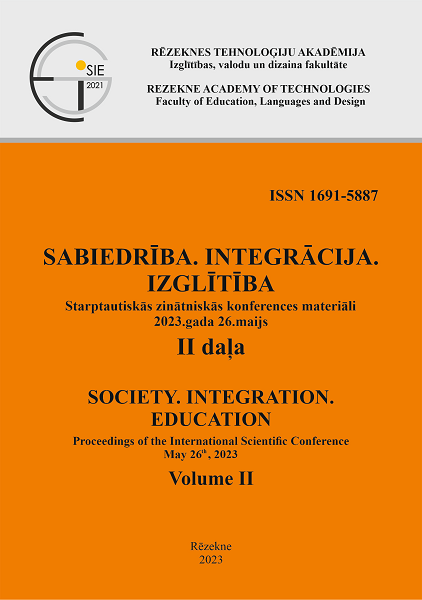GENERAL AND SPECIFIC FACTORS OF FUTURE ORIENTATION LINK TO AWARENESS OF MEANING IN LIFE
DOI:
https://doi.org/10.17770/sie2023vol2.7104Keywords:
future orientation, general factor, meaning in life, specific factorsAbstract
Future orientation reflects individual orientation toward personal goals, including cognitive representations of these goals and goal-directed behavior. Recent meta-analytical studies confirmed the positive effects of future orientation in various life domains. The effect of goal-orientedness in developing meaning in life still needs to be explored. This study accounted for the variability of personal goals across the life span and socialization trajectories. It focused on the relationships between a complex factorial structure of future orientation and the presence of meaning in life in emerging adults acquiring tertiary education. In total, 555 students participated in the study (mean age was 21.13, SD = 2.45, 64% females). The Individual Future Orientation Scale and Meaning in Life Questionnaire were applied for measurement. The factor analysis demonstrated that the bifactor model of future orientation includes the general factor and additional specific factors of future-oriented behavior and family-related goals. The general future orientation and future-oriented behavior positively predicted the presence of meaning in life. The emphasis on future-oriented behavior in a complex prediction is in line with the significance of the purpose in life for subjective awareness of meaningful life.
References
Andre, L., van Vianen, A. E. M., Peetsma, T. T. D., & Oort, F. J. (2018). Motivational power of future time perspective: Meta-analyses in education, work, and health. PLoS One 13: e0190492. DOI: https://doi.org/10.1371/journal.pone.0190492
Baumeister, R. F., & Wilson, B. (1996). Life stories and the four need for meaning. Psychological Inquiry, 7(4), 322–325. DOI: https://doi.org/10.1207/s15327965pli0704_2
Chen, F. F., Hayes, A., Carver, C. S., Laurenceau, J. P., & Zhang, Z. (2012). Modeling general and specific variance in multifaceted constructs: A comparison of the bifactor model to other approaches. Journal of Personality, 80, 219–251. DOI: https://doi.org/10.1111/j.1467-6494.2011.00739.x
Dueber, D. M. (2021). BifactorIndicesCalculator: Bifactor Indices Calculator. R package version 0.2.2. Retrieved from: https://CRAN.R-project.org/package=BifactorIndicesCalculator
Emmons, R. A. (2003). Personal goals, life meaning, and virtue: Wellsprings of a positive life. In C. L. M. Keyes & J. Haidt (Eds.), Flourishing: Positive psychology and the life well-lived, pp. 105–128. American Psychological Association. DOI: https://doi.org/10.1037/10594-005
Hu, L., & Bentler, P. M. (1999). Cutoff criteria for fit indexes in covariance structure analysis: Conventional criteria versus new alternatives. Structural Equation Modeling: A Multidisciplinary Journal, 6(1), 1–55. DOI: https://doi.org/10.1080/10705519909540118
Kolesovs, A. (2017). Individual future orientation and demographic factors predicting life satisfaction. In V. Lubkina, I. Baranauskiene, & K. Mārtinsone (Eds.), Society, Integration, Education: Vol. 1, Proceedings of the International Scientific Conference, pp. 534–543. Rezekne: Rezekne Academy of Technologies. DOI: https://doi.org/10.17770/sie2017vol1.2448
Kolesovs, A. (2019). Adaptation of the Meaning in Life Questionnaire in Latvian. Sociālo Zinātņu Vēstnesis/Social Sciences Bulletin, 1(28), 109–120. Retrieved from: https://du.lv/wp-content/uploads/2019/07/SZV_2019-1_7-Kolesovs.pdf
Lui, W.-K., Chan, C.-K., Ng, K.-H., Chui, C.-F. R. C., Siu, N. Y.-F., Yung, C.-S., & Lau, K.-W. (2022). Awareness of meaning and quest for meaning: The mechanisms between future orientation and prosociality among youth during pandemic. Frontiers in Psychology, 13:1046803. DOI: https://doi.org/10.3389/fpsyg.2022.1046803
Miconi, D., Geenen, G., Frounfelker, R. L., Levinsson, A., & Rousseau, C. (2022). Meaning in life, future orientation and support for violent radicalization among Canadian college students during the COVID-19 pandemic. Frontiers in Psychiatry, 13:765908. DOI: https://doi.org/10.3389/fpsyt.2022.765908
Moshagen, M., & Erdfelder, E. (2016). A new strategy for testing structural equation models. Structural Equation Modeling, 23, 54–60. DOI: https://doi.org/10.1080/10705511.2014.950896
Nurmi, J. E. (2004). Socialization and self-development: channeling, selection, adjustment, and reflection. In R. M. Lerner and L. Steinberg (Eds.) Handbook of Adolescent Psychology, pp. 85–124. Hoboken, NJ: Wiley. DOI: https://doi.org/10.1002/9780471726746.ch4
Rodriguez, A., Reise, S. P., & Haviland, M. G. (2016). Applying bifactor statistical indices in the evaluation of psychological measures. Journal of Personality Assessment, 98, 1–15. DOI: https://doi.org/10.1080/00223891.2015.1089249
Rosseel, Y. (2012). lavaan: An R package for structural equation modeling. Journal of Statistical Software, 48(2), 1–36. DOI: https://doi.org/10.18637/jss.v048.i02
Seginer, R. (2009). Future orientation: Developmental and ecological perspectives. New York, NY: Springer. DOI: https://doi.org/10.1007/b106810
Seginer, R., Vermulst, A., & Shoyer, S. (2004). The indirect link between perceived parenting and adolescent future orientation: A multiple-step model. International Journal of Behavioral Development, 28(4), 365–378. DOI: https://doi.org/10.1080/01650250444000081
Steger M. F., Frazier P., Oishi S., & Kaler M. (2006) The Meaning in Life Questionnaire: Assessing the presence of and search for meaning in life. Journal of Counseling Psychology, 53(1), 80–93. DOI: https://doi.org/10.1037/0022-0167.53.1.80
Zimbardo, P. G., & Boyd, J. N. (1999). Putting time in perspective: A valid, reliable individual-differences metric. Journal of Personality and Social Psychology, 77, 1271-1288. DOI: https://doi.org/10.1037/0022-3514.77.6.1271






